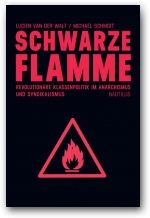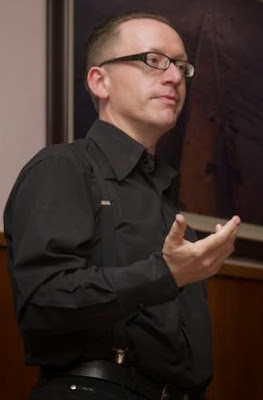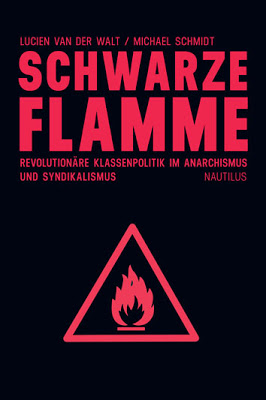
Alex Zukas, (2013), "
Black Flame: the revolutionary class politics of anarchism and syndicalism,"
Labor History, volume 54, number 1, pp. 113-115
Just published, Alex Zukas's positive (but at times critical: see below) review praises
Black Flame as a
"a rich, provocative, and important study of anarchist history, theory, and practice." It is a
"wide-ranging intellectual and political history that will surely stimulate debates about anarchist theory and practice." The authors "synthesize a vast amount of primary and secondary source material on anarchism, their points are easy to follow, their arguments are clearly stated, they address key debates within anarchist politics and anarchist scholarship, and they take clear positions on those debates which are likely to generate even more debate." It also fosters new work by raising a "host of issues for future research starting with most of its main arguments"
Zukas also provides a succinct summary of those "main arguments" which is worth reproducing for its clarity: "The main arguments of the book, all of which challenge widely held views about anarchist history, theory, and practice are
(1) the anarchist tradition begins in the 1860s as a response to the rise of capitalism and the modern state and emerged with, and was part of, modern socialist and proletarian movements;
(2) not all philosophies that are hostile to the state or promote individual freedom are anarchist because anarchism is the libertarian wing of socialism which seeks to collectivize and self-manage production and replace the modern state with international self-management;
(3) historians need a global perspective to counter the pervasive idea of ‘Spanish exceptionalism’ because major mass anarchist movements developed outside Spain in Argentina, Brazil, Chile, Cuba, France, Mexico, the Netherlands, Peru, Portugal, and Uruguay and often constituted the majority of organized workers in those nations from 1895 to 1925;
(4) anarchist ideas have internal coherence;
(5) the politics of class struggle, counterpower, and counterculture are integral to anarchism and syndicalism;
(6) anarchism has always been predominantly a modern urban working-class movement rather than a rural peasant movement; and
(7) anarchist and syndicalist trends are central to comprehending the history of labor and the Left in much of the world."
While Zukas does not dispute any of these major claims, he
does suggest that there is a tension in
Black Flame between its "scholarly or academic agenda" and "polemics of a more partisan agenda that involves building a cohesive anarchist movement today." This (he claims) can lead the latter to sometimes "undermine" or "overshadow" the former, leading the book to have "mixed" results. His main examples of this apparent flaw are that
1) Black Flame does not pay adequate attention to overlaps within the "broad revolutionary Left" and its "permeable boundaries" (his main example here are the De Leonists)
2) it "exhibits a tendency toward a caricatured, tendentious, reified, and reductive view of Marxist politics by means of selective quotation and by reducing Marxism to Leninism (Stalinism, really)"
3) Black Flame
is critical of classical Marxism yet fails to provide much "critical
assessment of Bakunin’s and Kropotkin’s key ideas."
Short response:
As with all reviews, there is much food for thought in the criticisms
provided; critique is not a threat to scholarship, but central to its
progress, and so, always welcome.
It is in the same spirit of engagement, then, that I will post this short (I was going to say "brief," but it grew in the telling) response.
I would suggest that Zukas's general claim that "partisan" concerns undermine "academic" claims is a bit overstated. As he points out, the mixed mode of scholarship and advocacy is in the best "tradition of a great deal of labor scholarship" and is "laudable"; it is only a problem if the "partisan" position weakens the "scholarly" quality.
But has Zukas shown this? Yes and no, no, and, last,yes but no...
1) Yes and no: Black Flame focuses on the core of the anarchist and syndicalist tradition, and not on the overlaps and syntheses that emerged at its boundaries. So, yes, the issue of fuzzy boundaries is not central to its project and while it certainly merits more discussion, it is a matter for another project. This focus is not an example of partisanship undermining scholarship, but simply an issue of coverage.
It should also be noted that, within this necessary limitation,
Black Flame does in fact discuss a number of examples of such overlaps and syntheses, among them the Industrial and Commercial Workers Union of Africa, the 1920s-1930s Sandino movement, and the impact of nationalism upon a wing of the Korean and Chinese anarchists.
The issue of De Leonism is quite separate, however, from this matter.
Black Flame specifically, and at some length, rejects the view that De Leonism is an example of a synthesis or overlap. The
correctness of that argument can be disputed, but it is a separate matter to the question of the importance of examining "permeable boundaries," since the case for De Leonism being an expression of blending at the boundaries must first be made.
Last on this point: as the points about Sandino
etal underline, there have always been "permeable boundaries" on the "broad revolutionary Left," and indeed, between that Left and a range of other forces - not all revolutionary, and not all Left. That some permeability exists is undeniable, but this it is at the
boundaries that exist
between traditions; the fact of permeability does
not efface very real, fundamental differences, and to identify those differences is not partisan, but a necessary part of scholarly analysis.
Nor should permeability on the "broad revolutionary Left" be overstated. Such matters such as the 1872 split in the First International, the systematic drive to purge anarchists and syndicalists from the Second and Third Internationals, the repression that was meted out by Marxists against anarchists and syndicalists in Russia, Korea, Spain, Greece, Bulgaria, Cuba and elsewhere is certainly
not the whole history of the "broad revolutionary Left," but they
are an enormous part of that history.
That said, the issue of overlaps and syntheses is an important one, deserving of more attention in its own right. So, with the reservations expressed above, that point is taken.
2)
No: Black Flame does not provide a "caricatured, tendentious, reified, and
reductive view of Marxist politics" by "selective quotation" and
"reducing Marxism to Leninism (Stalinism, really)."
As we have argued in
Black Flame and elsewhere, Marxism is not homogenous; it includes, indeed, a libertarian wing closely akin to anarchism.
Zukas notes this nuanced approach, but then wishes to suggest that
Black Flame caricatures Marxism with a
"reductive view" based on "selective quotation" and stressing "Leninism (Stalinism, really)."
The problem with Zukas's point is that the dominant tradition in Marxism has always been statist; the history of countries like the Soviet Union etc., and of the big parties of the Second and Third Internationals (and the smaller but sometimes pretty substantial parties of the Fourth) is not just a minor moment in Marxism, but the bulk of its history. That is the Marxist tradition that most Marxists have always embraced, and that is
why that tradition (explicit) forms the focus of
Black Flame in discussing Marxism.
Therefore, quoting Marx, Engels, Kautsky, Lenin, Trotsky, Stalin, Mao and Guevara is not really being "reductive" or "selective," but instead, being
representative and
reasonable; the same applies to linking "Marxism to Leninism (Stalinism, really)." One may not like "Stalinism," after all, but it would be a caricature of Marxism as a mode of thought stressing material realities, if one was to discuss Marxist politics as if the Soviet Union or "Stalinism" never existed.
3)
Yes, but no: it is quite true that
Black Flame does not provide a detailed criticism of Bakunin's and Kropotkin's "key ideas," but that was
not its aim; the aim was, first and foremost,
recovery of those core ideas, and of their expression in a revolutionary
praxis internationally.
The critical discussion of classical Marxism presented in
Black Flame is, by the same token, primarily about recovering the
anarchist and
syndicalist critique of classical Marxism and its analytical and political alternative to classical Marxism. Likewise,
Black Flame provides a critical evaluation of many of the major debates and disputes within the broad anarchist tradition,
in order to better understand that tradition's ideas and historical record.
To put this another way: revisiting the anarchist/ Marxist debate, and recapitulating, in all its force, the anarchist and syndicalist critique of many fundamental Marxist positions is a necessary
method for examining real, fundamental
differences; it is not partisan, so long as the account is fair. And as suggested above,
Black Flame provides a fair account of the dominant Marxist positions.
A critical assessment of the "key ideas" of Bakunin and Kropotkin on their own terms, and in place of the caricatures that bedevil the literature, is long overdue, and
welcome. However, that task, too, falls beyond the scope of
Black Flame.
In closing here, again the point is taken - as indicating an issue deserving of more attention in its own right - but with with reservations.
Lucien
 Beitrag für die Sendung "Klasse Kommunisten" von Ulrich Hufen (Gutenbergs Welt, WDR 3) (zum Nachhören der ganzen Sendung)
Beitrag für die Sendung "Klasse Kommunisten" von Ulrich Hufen (Gutenbergs Welt, WDR 3) (zum Nachhören der ganzen Sendung)




